转载自:《用Python控制硬件46-低电压启动与可靠性测试》
产品研发阶段,有时需要了解在低电压供电时,设备能否依旧正常启动并工作,可以搭建如下的测试系统:
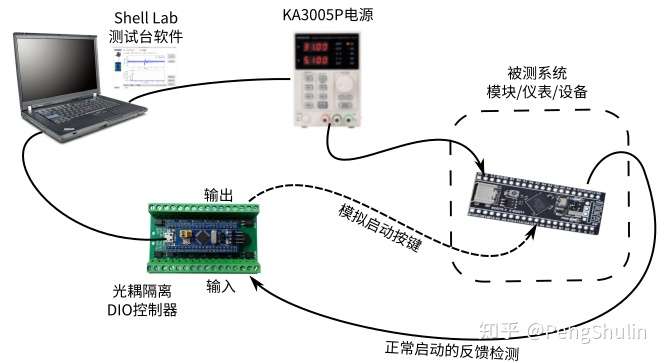
1、控制可编程电源输出测量电压。
2、使用光耦隔离数字IO板,检测被测系统的上电反馈,比如之前介绍的4款实验板,启动后LED灯都会0.5Hz频率闪烁,可以将LED的控制PIN脚接入光耦输入。
3、如果被测系统需要额外的启动开关按钮,可以将光耦输出到按钮信号线上,模拟开机动作。如果系统比较特殊,需要按下特殊功能键才能检测到反馈,也可以用此方法。
4、使用Shell Lab软件脚本控制测试整个流程,或者直接编写命令行下的Python脚本。
图中的DIO控制器是之前介绍的简易实验板+底板构成,可以控制8个光耦输入和8个光耦输出。
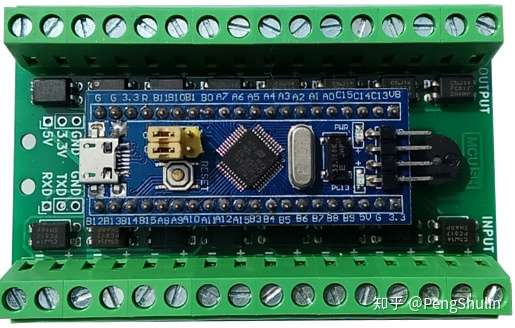
用实验板举例,按上面方式进行测试:
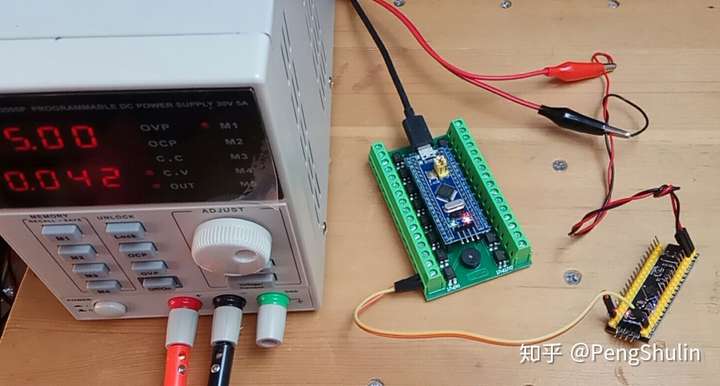
下面的代码输出正常工作电压,反复开关,检测实验板能否正常启动:
VOLTAGE = 5.0 # Volt
CURRENT = 5.0 # Amp
DETECT_PIN = '1.8' # PB8 to detect LED feedback
DETECT_TIMEOUT = 5 # 检测超时 in seconds
DETECT_DEBOUNCE = 0.4 # 去抖动 in seconds
dio = Mcush.Mcush('/dev/ttyACM1')
dio.pinInput(DETECT_PIN)
power = Korad.KA3005P(PORT)
power.output( VOLTAGE, CURRENT )
v, a = power.getSetting()
info( 'Set: %.2f V / %.2f A'% (v, a) )
counter, counter_succ, counter_err = 0, 0, 0
while True:
# power off
power.outputDisable()
time.sleep(0.5) # wait for voltage drop down
# power on
power.outputEnable()
# detect with timeout and debounce
detected = False
t0 = time.time()
while time.time() < t0 + DETECT_TIMEOUT:
t1 = time.time()
while True:
pin = not dio.pinRead(DETECT_PIN)
if pin:
if time.time() > t0 + DETECT_DEBOUNCE:
detected = True
else:
break
if detected:
break
if detected:
counter_succ += 1
else:
counter_err += 1
counter += 1
info( 'Count: %d Succ: %d Err: %d'% (counter,
counter_succ, counter_err) )
测试状态计数值显示在底部:
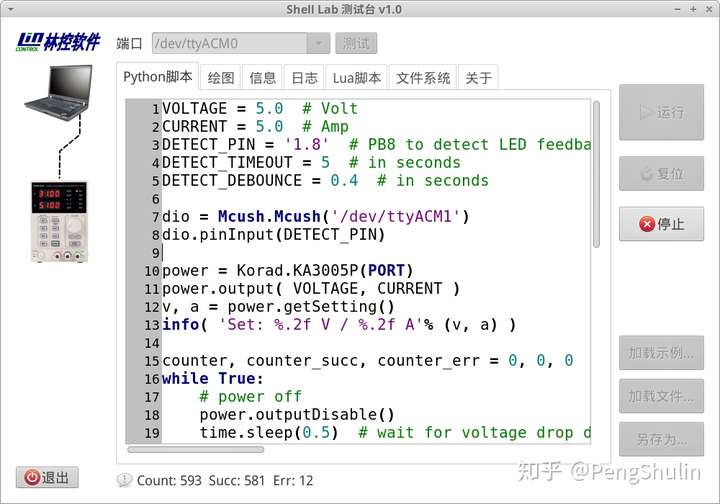
下面脚本输出从低到高线性增加的电压,监测是否能否启动工作:
VOLTAGE_MIN = 1.0 # Volt
VOLTAGE_MAX = 5.0 # Volt
VOLTAGE_STEP = 20 # steps number
CURRENT = 5.0 # Amp
DETECT_PIN = '1.8' # PB8 to detect LED feedback
DETECT_TIMEOUT = 5 # in seconds
DETECT_DEBOUNCE = 0.4 # in seconds
dio = Mcush.Mcush('/dev/ttyACM1')
dio.pinInput(DETECT_PIN)
power = Korad.KA3005P(PORT)
power.outputDisable()
p = getPlotPanel()
p.addPlot( 'result', 111, label_y='Succ', label_x='Voltage' )
p.setLimit( 'result', top=1.1, left=VOLTAGE_MIN, right=VOLTAGE_MAX, auto=False )
p.setLinestyle( 'result', ['-o'] )
volt_list = linspace(VOLTAGE_MIN, VOLTAGE_MAX, num=VOLTAGE_STEP)
for volt in volt_list:
# output voltage
power.output( volt, CURRENT )
v, a = power.getSetting()
info( 'Set: %.2f V / %.2f A'% (v, a) )
# detect with timeout and debounce
detected = False
t0 = time.time()
while time.time() < t0 + DETECT_TIMEOUT:
t1 = time.time()
while True:
pin = not dio.pinRead(DETECT_PIN)
if pin:
if time.time() > t0 + DETECT_DEBOUNCE:
detected = True
else:
break
if detected:
break
# 绘图输出结果,1-正常 0-异常
p.addData( 'result', int(detected), volt )
# power off
power.outputDisable()
time.sleep(0.5) # wait for voltage drop down
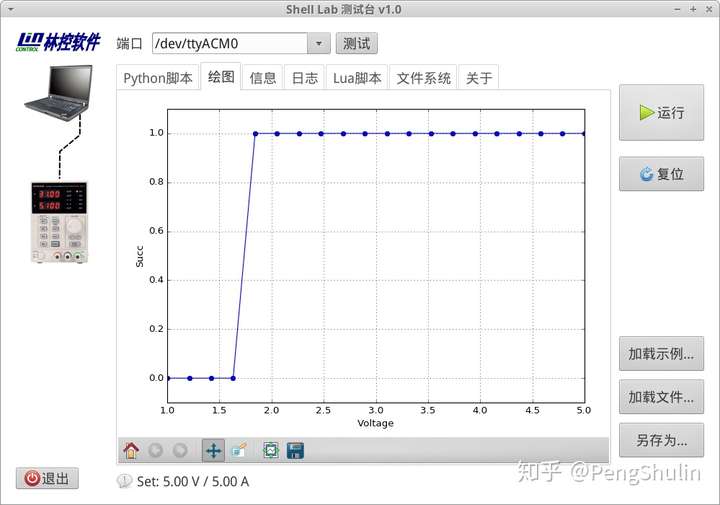
缩小范围1.5V~2.0V,细化一下:
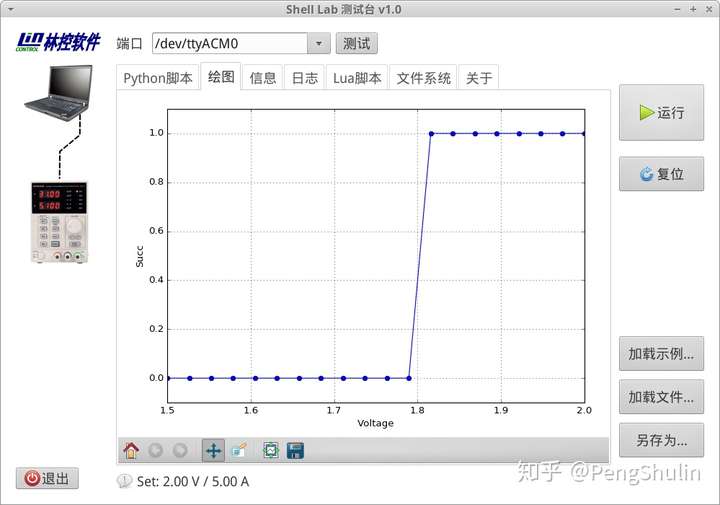
可以清楚地看到,板子在1.8V以下无法启动。
此实验只是演示作用(实验板通常稳定5V供电),在电池供电的手持设备测试中更具有实际意义。
